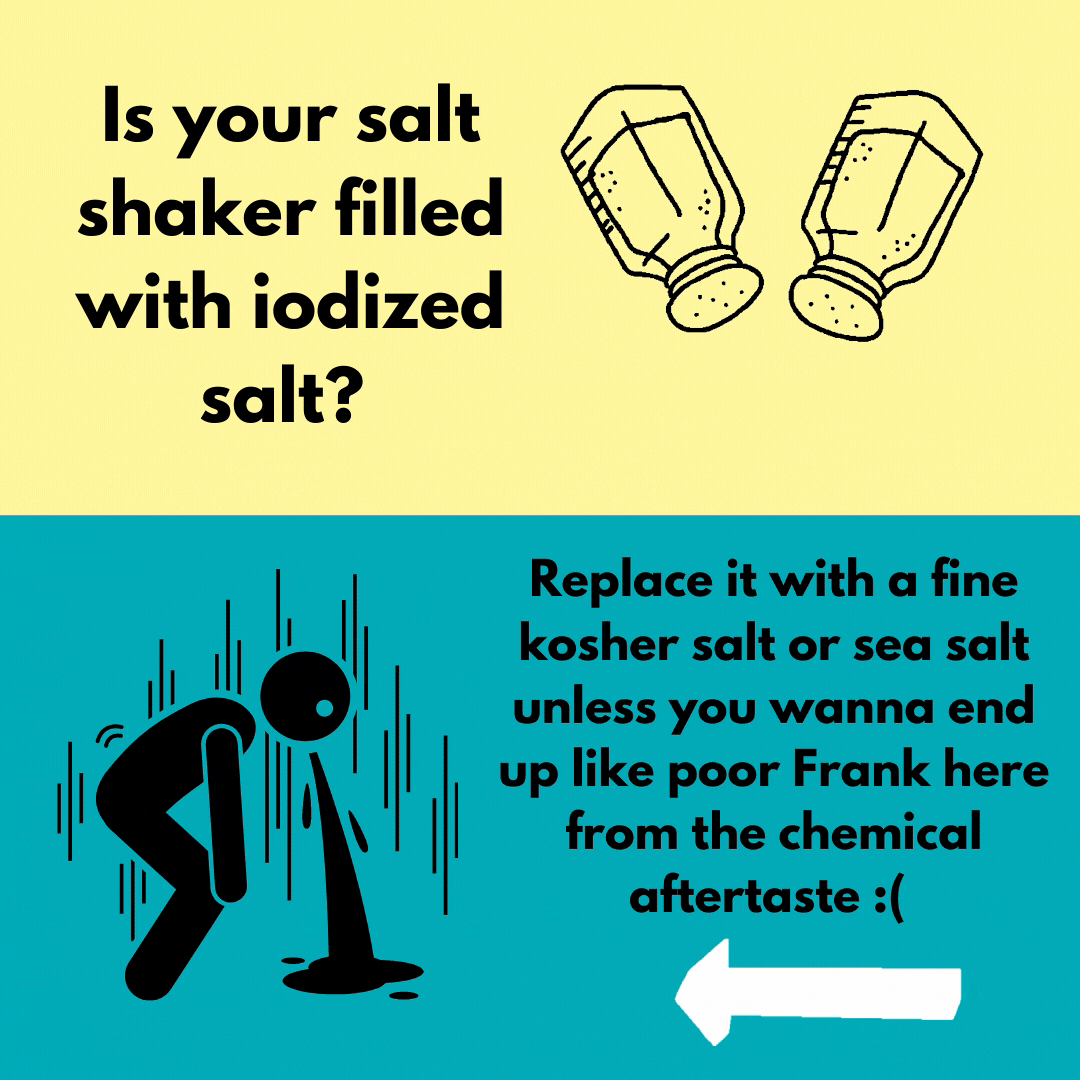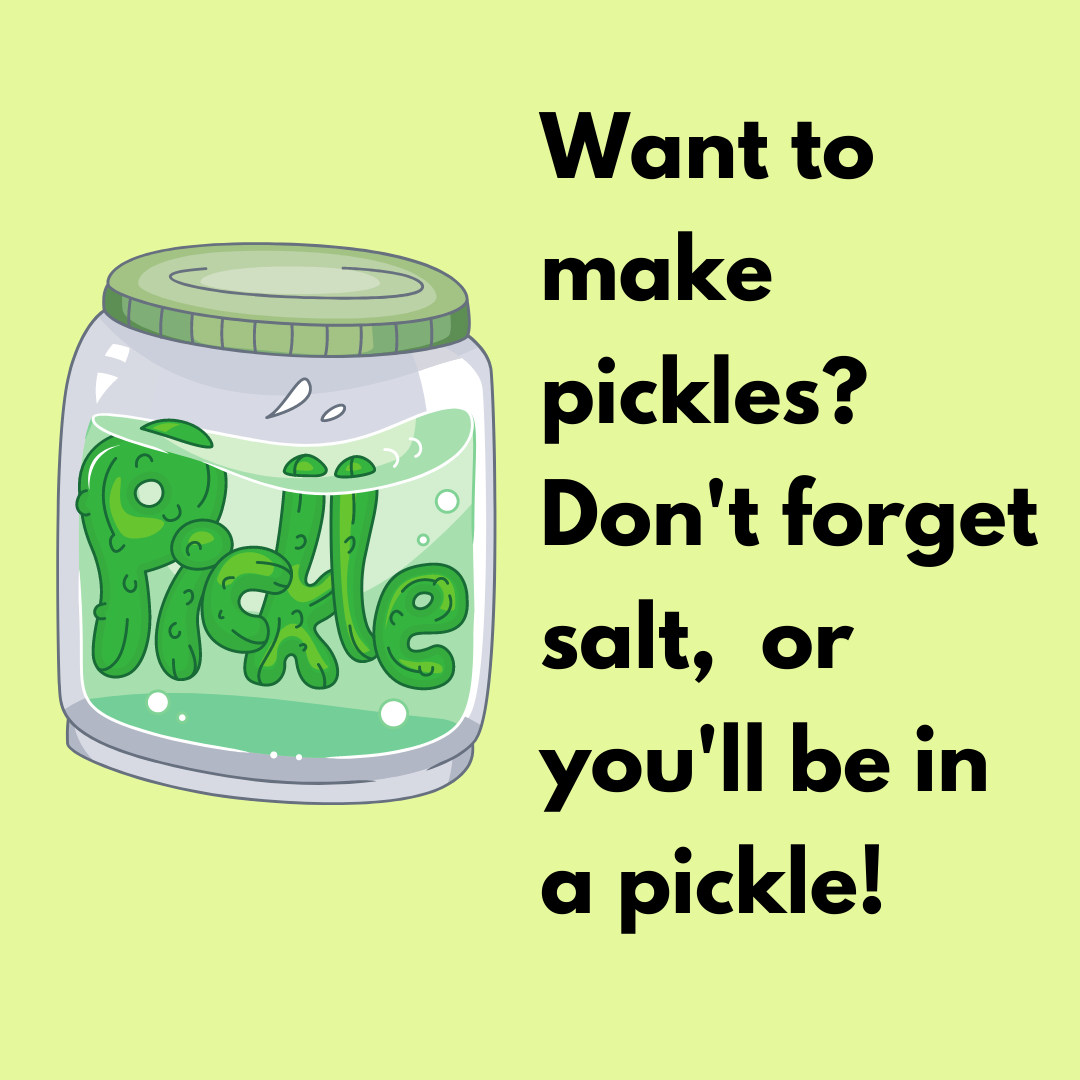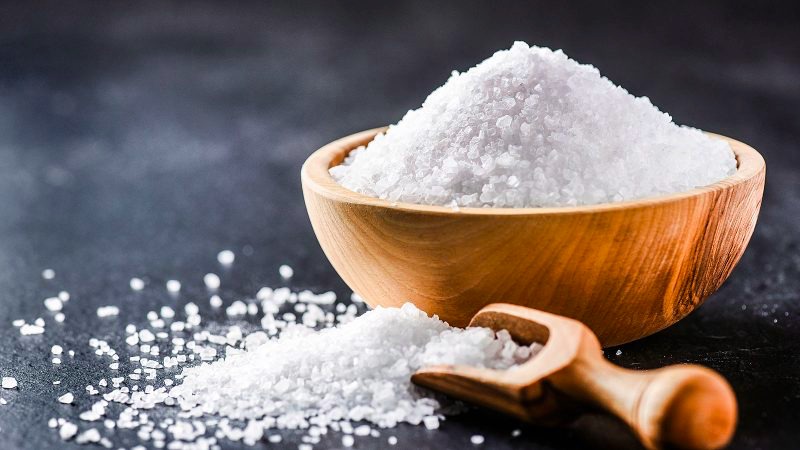I think it’s okay to be salty. No no no..not towards your friends. Well, unless they left you on read for a week, then it’s okay. But really! Salty is a good thing and everyone needs to be educated on why it’s the foundation of all the flavorful morsels of food that satisfy your palate.

You don’t have to be a chef to know how to use salt
For my non-chefs and cooks reading, let me explain what I mean by ‘seasoning your food’ before going any further. Just because you read the word season, doesn’t mean I’m sayin’ to go pull out grandma’s favorite lemon pepper, garlic powder, smoked paprika and every spice known-to-woman.
***I’m merely talking about SALT.***
A few salty pointers:
- A nicely-balanced dish has the perfect amount of salt and acid, and when referring to something being perfectly ‘seasoned’ in kitchen lingo, it means salt and acid.
- Spices add additional flavor to what you’re cooking. (that’s not what this blog is about).
- Salt brings out and compliments the natural flavor that is already present. Keep your spices in your cupboard for now, honey buns, and push that lemon pepper to the very back.
Season As-You-Go
No, you don’t want your food to taste salty, because that means it’s dreadfully over-seasoned. But, you do want to take the time to season your food little-by-little throughout the cooking process which gives you better control and makes over-seasoning less-likely.
Tasting “salty” vs being well-seasoned
You should never taste salt. Food shouldn’t taste salty, it should taste seasoned. If you can actually taste the salt and you want to spit it out because it tastes like the ocean, then I hope you have a compost bucket for that food you just wasted.
If you did a blind taste-test of 5 different types of salt, let’s say:
- table salt
- kosher salt
- sea salt
- fleur de sel
- pink salt
Then of course you’re going to taste the differences in their own distinct flavor. For example, the reason pink salt is pink is that they add pink dye. Okay kidding, it gets its pink color from potassium, calcium and magnesium. If you were a salt taster equivalent to…let’s say a sommelier, then you would be able to taste those subtleties.
We just want our food to taste good
Most of the population just uses salt to season their food, not to taste the different subtleties of salt. With all salts (Fluer De Sel being the exception), you’ll find that first you get salty, then you’ll taste minerals, then you’ll taste bitter.
Fleur De Sel does not have a bitter aftertaste and is the purest form of salt you can get on the market today. It has no mineral flavor or impurities from the sea like the others.
Fluer De Sel VS Sea Salt
Fluer de sel is compared to sea salt like Cinderella is compared to her evil stepsisters. Her stepsisters have it all but were always jealous of what they couldn’t be. I love sea salt and would choose it any day over table salt, but it just does not compare to its sister, Fluer De Sel.
Sea Salt
- Easily forms on the beds of seawater once the water is evaporated.
- Not as weather-temperamental.
- Forms as a grain, not as a crystal.
- Used throughout the cooking process.
Fleur De Sel
- Extremely temperamental and does not form as easily as sea salt.
- Forms on the surface of the water and are dependent on the perfect weather conditions, most importantly, temperature and wind.
- When the salt crystals do form, they take the shape of a pyramid or diamond and are actual salt crystals.
- (unfortunately, if you take these to the pawnshop, they won’t be worth much).
- They need to be carefully harvested by hand, evenly dried so as not to crush the crystals.
- A delicacy that it’s mostly used as a finishing salt.
Table salt is not from the ocean; it’s mined like coal (kinda)
First of all, it’s as processed as it gets. We’re talkin’ American cheese type-of-processed.

YUCK.
Here’s how it’s made:
- It’s not from the sea at all and is made by injecting water into underground salt deposits which makes a soupy brine (perfect for a thanksgiving turkey, jk).
- Heat is then applied which causes steam to form and water to evaporate, eventually leaving the salt beds behind.
- Then, it’s further processed in factories, pumped with loads of iodine and ground so finely that you can barely see it touch your food.
(It’s so fine and processed that it doesn’t aid in forming a solid crust when searing your meat either.)
I’m not going to pretend to be a scientist and explain what chemical reaction does or does not happen (shoutout to Bill Nye The Science Guy), but just know that you will not get the same sexy caramelization with table salt.

What salt I recommend to use
I recommend coarse-ground kosher salt because the tiny little salt rocks also help to add texture. The taste of table salt is pretty horrible also, quite like a mouthful of chemicals. But hey, if you’re the type that’s into smelling sharpies and gasoline, then maybe it’s for you! We’re all into weird things after all.

Why the heck is iodine even added to salt?
Believe it or not, iodine is a crucial mineral to make hormones for our thyroid. It’s one of those pesky little things that our body doesn’t produce but requires.
1. Medical reasons
Important bodily functions like our metabolism, as well as bone and brain development in infants, are controlled by our thyroid hormones.
Quick history
Over 100 years ago, there was an influx in the population developing goiters. It’s a medical condition where the thyroid in your neck becomes enlarged due to an iodine deficiency.
***(do me a favor and don’t Google Image goiters unless you want to be grossed out).
Since 1924, iodine has been added to our table salt in an attempt to solve the goiter dilemma and many years of research later, proved to help to decrease not just goiters, but mental retardation. As many jokes as I initially wanted to crack about them choosing salt of all things to put iodine in, it was actually pretty genius. If there is one thing we put on everything, it’s salt.
2. Iodine deficiency in American diets
1/3rd of the population still has an iodine deficiency in their diet, with most of those people being in third-world countries and Europe. In America, it doesn’t seem to be a common issue anymore, as we get our iodine from the foods we eat like seafood, dairy, eggs, fruits and veggies.

How do you know when something is well-seasoned?
I wish I could say there was a rule book for how much salt to use for every type of food and in every volume, but developing a palette for this just takes time.
The best way to become familiar with seasoning your food is by adding salt throughout the cooking process.
I can’t stress this enough…TASTE. YOUR. FOOD.
You have no idea how many times I’ve heard that in the kitchens I’ve worked in, and for good reason.
My best dating advice for your food relationship:
- Dumping a bunch of salt at the beginning stages in your soup without tasting it sounds like an abusive relationship to me.
- You need to make love to your food and season it gradually. No one-night stands here.
Cooking is romantic. Let me walk you through how to make a stew with love and why perfectly seasoning it matters
(PS this is not a recipe, just a description of steps)
- Pat your meat dry with paper towels.
***Moisture is the enemy to getting a good sear. - Heavily season your meat.
- Get your pan hot…like smokin’ hot. 😉
- Add your olive oil and place your meat in the pan. Away from you please – don’t want to scar that pretty face.
***Those natural sugars and proteins start to break down and become beautifully dark brown and caramelized (thanks for the help, kosher salt). - Remove your meat and let it rest on a baking sheet. Keep your pan hot, but not too hot.
- Add your veg, some salt, and sweat. I don’t mean sweat out of your pores; I mean to cook your veg slowly and at a low temperature to avoid any caramelization.
There will be delicious salty pieces of fond (crispy bits from searing your meat) in the bottom of the pan that will also help to season your veg..another reason to always be tasting. If it tastes too salty to you at this point, that’s OK, you will be adding stock which will decrease the saltiness.
Be patient, time is flavor
If you don’t take your time on each step and try to rush the process, Stewy will feel neglected. A neglected stew means you won’t get to experience the life-changing bite you were hoping for when it’s ready to be pulled out of the oven. It just wants to be noticed and paid attention to like any other relationship.
- Romance the veg at low heat until it’s translucent and tender like my heart, taste again, increase your heat and add your tomato paste. Stir it around and let it caramelize.
- Deglaze with red wine (add the red wine to remove the tasty bits of fond stuck on the bottom of the pan and reduce it by half.
- Add a can of San Marzano tomatoes, or whatever brand you desire, and taste again.
- Adjust seasoning if you need to.
- Add your stock, and yet again, taste and adjust your seasoning.
- Put it in the oven, low and slow, and let it braise for hours (and don’t bother it)!
At this point you’ll have been attentive throughout the entire cooking process, tasting it at each step, witnessing the transformative depth of flavor building and layering. It’s truly a beautiful thing.
If you’re not the romantic type, I guess what I’m trying to say is that you can have a better understanding of food and how salt develops mouthwatering flavor if you taste it throughout the cooking process. You will be floored. Only if you didn’t clean up that grease that splattered on the floor when you seared that meat.
Why do I need to add salt throughout the cooking process if I can just season it at the end?
Because salt isn’t just used to season things! It’s used to help your food cook more evenly and more quickly.
How is that, you ask?
- Salt brings out the natural moisture of whatever you’re cooking. If you try to sauté veggies in a hot pan without oil or salt, they will burn because they are dry against the pan.
- If you put salt on those veggies, you’ll see how much moisture will naturally come out while they’re cooking. Similar to how sugar pulls out the moisture when macerating fruits.
My advice to you? Just save yourself the headache and don’t sauté without oil or salt (unless it’s for dietary restrictions, of course)!
It’s also important to note that you’re not necessarily trying to season your whole dish at the very beginning. You’re just helping your veggies break down better and easier with a little salt. What you may also not realize is that you’re building different complexities of flavor by adding salt at different stages in the cooking process.
What else can you do with salt, and is it just to make food taste better?
Well, aside from preventing a slip on your bum this winter, salt is a crucial ingredient in food and not just from a taste & flavor perspective.
- Ever notice how some thanksgiving turkeys are really juicy and perfectly seasoned?
- Or how others are so dry and bland that your jaw muscle looks like it’s been training with Arnold Swazzanager?
Chances are, those big tender birdies were brined in a salt-water solution and the desert-dry ones were not (unless you hammered that poor bird). Not only does the saltwater penetrate the muscle fibers and internally season the turkey, but it’s also breaking down the muscle fibers and tenderizing them so you won’t be chewing…

Salt actually keeps the moisture in
This is a common misconception that people have.
“Salt dehydrates you.”
“Salt dries things out.”
I once heard a cardiologist put that theory to bed after a similar comment was made to him. He responded, “No actually, salt is important for you to keep moisture in. It doesn’t dehydrate you…the only thing that dehydrates you is alcohol and not drinking enough water.”
Same concept for brining a turkey. Salt doesn’t make it dry, salt makes it moist and juicy.
If you’re not drinking enough water, you definitely want to make sure you’re getting enough salt so that your body can keep in the little water you are giving it. Also, try putting some electrolytes in your water which helps your body to stay hydrated.
Salt’s star role before refrigeration
Salt plays a crucial role in preserving foods and making them shelf-stable. Think about peanut butter, pickles, canned foods and basically EVERY food you find on grocery store shelves.
Before refrigeration was a thing (that may be hard for some of you Millennial and Gen Z brains to grasp), food had to be stored in a way that didn’t spoil it.
Families didn’t just kill a large boar, get their fill for the night and then say “welp, guess the rest is gonna rot away.” No, no, no, no. Believe it or not, we are much more wasteful as a society today than we were long ago when refrigeration was nonexistent. Salt was extremely important for extending the life of food.
A cool (pun intended) way to store food that could spoil, was in cold cellars or under cold river beds and wells in enclosed containers.

Other curing/preserving methods that people relied on
- Smoking – Using salt, low heat and smoke for long periods of time. This also imparts incredible flavor.
- Pickling – Using salt and vinegar, this pretty much keeps food good for eternity.
- Curing – Using primarily salt with a little sugar and pulls out moisture that causes it to spoil in the first place.
And guess what…they all require…that’s right, SALT.

See? salt…no, not sea salt…you see, salt has so many uses beyond just making food taste delicious! Through your brain for a loop there, you’re welcome.
What’s my go-to salt and how do you season with your fingers?
100% coarse-ground kosher salt, baby.
- Need a versatile salt that can be used for pickling, brining, searing a steak, roasting vegetables or finishing a poached egg, to name a few? Use kosher salt.
- Do you have a salt shaker? Throw it out.
- Do you have a salt grinder? Well, keep it for emergencies if you feel attached. But here’s what I suggest: get you a salt bae, ahem, I mean a salt jar.
- Designate a cute small bowl in your cupboard or you can even reuse a pint container from that takeout you had last week (hopefully you’ve cleaned it by now) and fill it up about a quarter to half-way with salt.
The benefit of a salt jar
It gives you CONTROL. You want to be able to feel the salt between your fingers and pinch as much or as little as you want.
When seasoning, use the three-pinch method; thumb, index, pointer. Grab a healthy pinch and raise your hand about 6 inches from the surface. Begin to sprinkle the granules like a beautiful snowy Christmas eve and watch how the height causes it to spread out and evenly blanket the surface of the food.
My favorite brands of salt?
Kosher salt is my all-time favorite versatile salt. This brand specifically, because I used it in my time cooking throughout the New England area. Although sentimental, I like this brand of kosher salt because it’s top-quality and hand-crafted for over 100 years with no additives. It leaves a pleasurable crunch in your mouth and the sound when sprinkling from your fingers is as satisfying as itching a mosquito bite.

Amagansett Sea Salt is a worldwide chef-respected and used brand of sea salt. Also carefully harvested by hand in Amagansett, NY. Their perfect recipe consists of sea, wind, sun and patience. I adore Amagansett Sea Salt so much, that I interviewed the founder, Steven, just for you to hear his fascinating story and why you should try it. You can find this episode here

Esprit Du Sel is one of the finest brands of fleur de sel, made and delicately harvested by hand in Isle of Rhé, an island off the west coast of France. It melts in your mouth like butter and is a top-dog in the world of salts.

Maldon Sea Salt Flakes is made by 4 generations of master sea salt makers in the coastal town of Maldon in the UK. I recommend going to their home page and clicking “Play Our Film” to be blown away by their beautiful history portrayed in stunning cinematography.

So all that to say what, Erika?
Salt is undoubtedly the bloodline of making all food taste good. Just like we’d be lifeless without blood, food tastes lifeless without salt. Understanding its properties and why it works to develop the flavor in each ingredient is the first step in appreciating the art of a perfectly seasoned bite of food. They don’t call it “salt-of-the-earth” for nothing.




